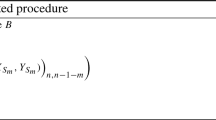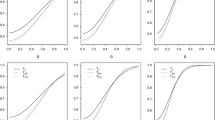Abstract
The Vale–Maurelli (VM) approach to generating non-normal multivariate data involves the use of Fleishman polynomials applied to an underlying Gaussian random vector. This method has been extensively used in Monte Carlo studies during the last three decades to investigate the finite-sample performance of estimators under non-Gaussian conditions. The validity of conclusions drawn from these studies clearly depends on the range of distributions obtainable with the VM method. We deduce the distribution and the copula for a vector generated by a generalized VM transformation, and show that it is fundamentally linked to the underlying Gaussian distribution and copula. In the process we derive the distribution of the Fleishman polynomial in full generality. While data generated with the VM approach appears to be highly non-normal, its truly multivariate properties are close to the Gaussian case. A Monte Carlo study illustrates that generating data with a different copula than that implied by the VM approach severely weakens the performance of normal-theory based ML estimates.



Similar content being viewed by others
References
Bentler, P. (2006). Eqs 6 structural equations program manual. Encino, CA: Multivariate Software.
Bentler, P. M., & Tong, X. (2013). Evaluation of a new mean scaled and moment adjusted test statistic for SEM. Structural Equation Modeling: A Multidisciplinary Journal, 20, 148–156.
Braeken, J., Tuerlinckx, F., & Boeck, P. (2007). Copula functions for residual dependency. Psychometrika, 72, 393–411.
Browne, M. W. (1984). Asymptotically distribution-free methods for the analysis of covariance structures. British Journal of Mathematical and Statistical Psychology, 37, 62–83.
Cario, M. C., & Nelson, B. L. (1997). Modeling and generating random vectors with arbitrary marginal distributions and correlation matrix. Technical Report, Department of Industrial Engineering and Management Sciences, Northwestern University, Evanston, IL.
Curran, P. J., West, S. G., & Finch, J. F. (1996). The robustness of test statistics to nonnormality and specification error in confirmatory factor analysis. Psychological Methods, 1, 16–29.
Fleishman, A. (1978). A method for simulating non-normal distributions. Psychometrika, 43, 521–532.
Fouladi, R. (2000). Performance of modified test statistics in covariance and correlation structure analysis under conditions of multivariate nonnormality. Structural Equation Modeling: A Multidisciplinary Journal, 7, 356–410.
Headrick, T. (2007). Methods for simulating real world data for the psycho-educational sciences. In S. Sawilowsky (Ed.), Real data analysis. Charlotte, NC: Information Age Publishing.
Headrick, T. C., & Pant, M. D. (2012). Simulating non-normal distributions with specified L-moments and L-correlations. Statistica Neerlandica, 66, 422–441.
Hofert, M., Kojadinovic, I., Maechler, M., & Yan, J. (2013). Copula: Multivariate dependence with copulas. R package version 0.999-7.
Joe, H. (1997). Multivariate models and multivariate dependence concepts. Boca Raton, FL: Chapman & Hall/CRC.
Jöreskog, K., & Sorbom, D. (2006). Lisrel version 8.8. Lincolnwood, IL: Scientific Software International.
Kotz, S., Balakrishnan, N., & Johnson, N. L. (2000). Continuous multivariate distributions. New York, NY: Wiley.
Mair, P., Satorra, A., & Bentler, P. M. (2012). Generating nonnormal multivariate data using copulas: Applications to SEM. Multivariate Behavioral Research, 47, 547–565.
Mardia, K. (1970). Measures of multivariate skewness and kurtosis with applications. Biometrika, 57, 519–530.
Muthén, L., & Muthén, B. (2010). Mplus software (version 6.1). Los Angeles, CA: Muthén & Muthén.
R Core Team. (2013). R: A language and environment for statistical computing. Vienna: R Foundation for Statistical Computing.
Rosseel, Y. (2012). Iavaan: An R package for structural equation modeling. Journal of Statistical Software, 48, 1–36.
Sklar, M. (1959). Fonctions de répartition à n dimensions et leurs marges. Université Paris 8.
Tadikamalla, P. R. (1980). On simulating non-normal distributions. Psychometrika, 45, 273–279.
Vale, C., & Maurelli, V. (1983). Simulating nonnormal distributions. Psychometrika, 48, 465–471.
Author information
Authors and Affiliations
Corresponding author
Rights and permissions
About this article
Cite this article
Foldnes, N., Grønneberg , S. How General is the Vale–Maurelli Simulation Approach?. Psychometrika 80, 1066–1083 (2015). https://doi.org/10.1007/s11336-014-9414-0
Received:
Published:
Issue Date:
DOI: https://doi.org/10.1007/s11336-014-9414-0




